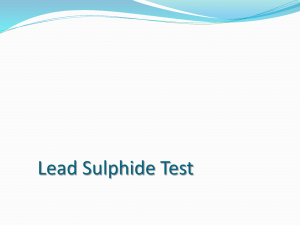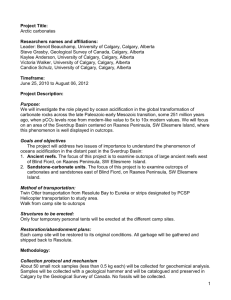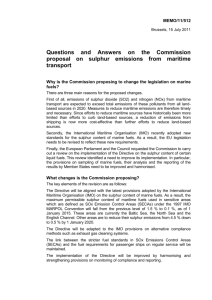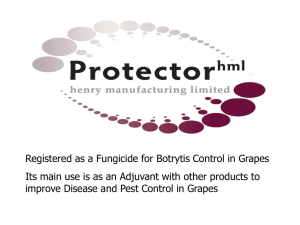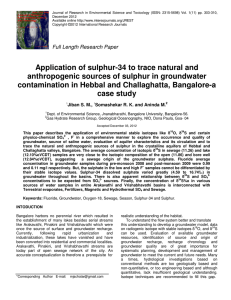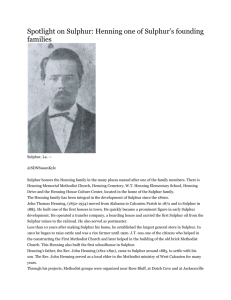Air Quality at Two Sites West of Calgary:
advertisement
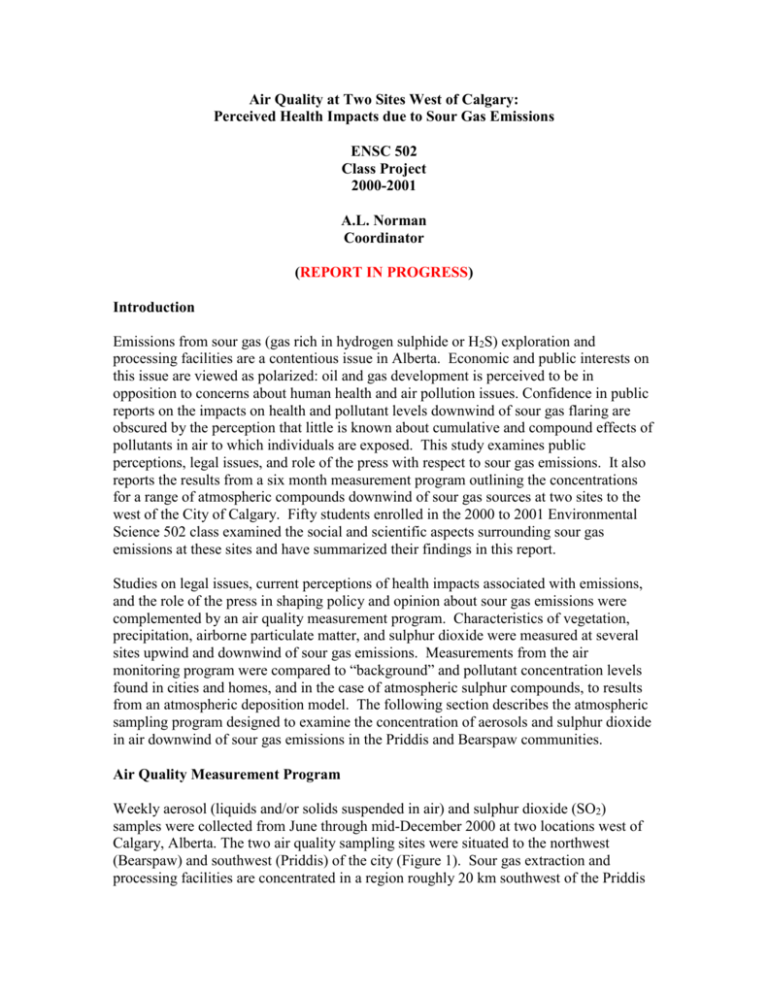
Air Quality at Two Sites West of Calgary:
Perceived Health Impacts due to Sour Gas Emissions
ENSC 502
Class Project
2000-2001
A.L. Norman
Coordinator
(REPORT IN PROGRESS)
Introduction
Emissions from sour gas (gas rich in hydrogen sulphide or H2S) exploration and
processing facilities are a contentious issue in Alberta. Economic and public interests on
this issue are viewed as polarized: oil and gas development is perceived to be in
opposition to concerns about human health and air pollution issues. Confidence in public
reports on the impacts on health and pollutant levels downwind of sour gas flaring are
obscured by the perception that little is known about cumulative and compound effects of
pollutants in air to which individuals are exposed. This study examines public
perceptions, legal issues, and role of the press with respect to sour gas emissions. It also
reports the results from a six month measurement program outlining the concentrations
for a range of atmospheric compounds downwind of sour gas sources at two sites to the
west of the City of Calgary. Fifty students enrolled in the 2000 to 2001 Environmental
Science 502 class examined the social and scientific aspects surrounding sour gas
emissions at these sites and have summarized their findings in this report.
Studies on legal issues, current perceptions of health impacts associated with emissions,
and the role of the press in shaping policy and opinion about sour gas emissions were
complemented by an air quality measurement program. Characteristics of vegetation,
precipitation, airborne particulate matter, and sulphur dioxide were measured at several
sites upwind and downwind of sour gas emissions. Measurements from the air
monitoring program were compared to “background” and pollutant concentration levels
found in cities and homes, and in the case of atmospheric sulphur compounds, to results
from an atmospheric deposition model. The following section describes the atmospheric
sampling program designed to examine the concentration of aerosols and sulphur dioxide
in air downwind of sour gas emissions in the Priddis and Bearspaw communities.
Air Quality Measurement Program
Weekly aerosol (liquids and/or solids suspended in air) and sulphur dioxide (SO2)
samples were collected from June through mid-December 2000 at two locations west of
Calgary, Alberta. The two air quality sampling sites were situated to the northwest
(Bearspaw) and southwest (Priddis) of the city (Figure 1). Sour gas extraction and
processing facilities are concentrated in a region roughly 20 km southwest of the Priddis
location, whereas oil and gas facilities span a wide area up to hundreds of kilometers to
the northwest of the Bearspaw site. Emissions from both oil and gas facilities are
expected to the have greatest impact on air quality when winds are from the southwest
and northwest respectively (Figure 2).
“Background” air is represented by a single continuous sample collected from January to
Y at a mountain in the Kananaskis region to the west of Calgary (Figure 3). The sampler
was placed near a ridge sloping east/west and away from local point sources of
contamination. The site is characterized by strong westerly winds and was notably dusty
at the time of sampling. The nearest westward pollutant sources are small resort towns
located hundreds of kilometers away in the Z valley and the Cominco smelter in
southwest British Columbia.
Aerosol and Sulphur Dioxide Sampling Methods
At the two sites west of Calgary, Alberta, sampling and meteorological instruments were
placed on the rooftops of buildings. Both sites were located on a topographical rise with
respect to westerly winds, and are expected to be representative of well-mixed air. The
sampling program was designed to encompass air originating from rural regions while
excluding air masses in contact with the city of Calgary. This was accomplished by
connecting a vacuum filtration system (Sierra Miscu high volume samplers) to an
anemometer (Figure 4). Meteorological data from the Bearspaw site was collected at 4.8
m height. At the Priddis location, the building is located on an upward slope; the
anemometer was situated nearest the side nearest to the south face of the building and
was 5.8 m above the ground. Local meteorological parameters such as wind direction,
wind speed, temperature and humidity were logged by a computer as one minute
averages and analyzed by a program that sent a signal to the high volume samplers to turn
on only when certain predetermined conditions were met. The high volume samplers
were operational only at wind speeds above 1 km/hour, and shut off for relative
humidities above 98 %. The sampler to the southwest of Calgary (Priddis), was
operational during winds from the southwest whereas the northwest site (Bearspaw)
sampled air only from northwesterly trajectories.
Air particles flowing through the vacuum pump were intercepted by a quartz fibre filter
paper with a 0.03 micrometer (µm) cutoff. A cellulose fibre filter paper treated with
potassium carbonate and glycerol was placed approximately 2 cm beneath the aerosol
filter on a modified sampling head to trap sulphur dioxide (Figure 5). Flow rates were 40
standard cubic feet per minute (scfm) and atmospheric concentrations were determined
by dividing the total mass of a given compound collected on the filter by the total volume
of air. Exposed filters were folded, face inward, and placed in clean aluminum foil inside
separate ziplock bags for transportation to the laboratory. Prior to dividing the filter for
analysis, samples were stored in a refrigerator at less than 0º C. Particulate matter on the
filters was analyzed to provide information on the amount of sulphate, metals, total
organic carbon, n-alkanes, and polycyclic aromatic hydrocarbons that were present.
After sampling quartz filters were handled with poyethylene gloves and were in contact
only with clean aluminum foil and ziplock bags prior to extraction. Field blanks
consisted of filters that were treated in an identical manner to sample filters, except that
air was not drawn through the filter face.
Sulphur Isotope Analysis
Natural abundance variations in sulphur isotope ratios can, in some instances, be used to
identify sulphur sources. Extensive work conducted by H.R. Krouse over the past 30
years has demonstrated the utility of sulphur isotopes in determining sulphur sources in
ecosystems within the Alberta environment (). The technique is based upon large
differences in the natural abundance ratio of 34S to 32S between “background” or natural
sulphur in the Alberta environment, and H2S associated with oil and gas reservoirs.
Differences in isotope ratios are small, in the parts per thousand range, and are expressed
on the d scale in permil (‰) relative to an international standard (in this case V-CDT).
34S = {((H/L)sample/(H/L)standard) – 1} x 103
(H/L)sample and (H/L)standard are the ratios of 34S to 32S in the sample and standard
respectively.
Samples containing more of the heavy isotope than the standard will have positive 34S
values whereas those containing less will have negative values.
Figure 6 shows the range in sulphur isotope composition for compounds that might be
expected in air in the Calgary region. Sulphur associated with sour gas in the province
has 34S values in the range of +15 to +30 ‰, with average values near +20 ‰ (Krouse,
1992). Sulphate derived from the oxidation of pyrite in glacial tills near Calgary, are
much more negative, from –8 to –12 ‰ (Hendry et al. 1986, 1989; Fennell, 1994).
Plants in the region are expected to derive the bulk of their sulphur from soil sulphate,
which is likely a mixture of sulphate from tills, fertilizer sulphate, and atmospheric
deposition with mixed isotope compositions. Rivers act as a mixing medium for these
various sources. The Bow River watershed was found to have 34S values between -2 ‰
and –10 ‰ downstream of Calgary in spring, summer, fall. The more conservative value
of –2 ‰ is used in this report as an average value for soil sulphate (Grasby, 1997).
Atmospheric sulphur in the region of Calgary, Alberta can be derived from a number of
sources including sour gas emissions, hydrogen sulphide from bacterial reduction of
sulphate in swamps, and vehicle exhaust. Bacterial sulphate reduction is a process in
which anaerobic bacteria utilize sulphate for their energy requirements. The reduction
process releases H2S, a pungent gas with a “rotten egg” smell, and is often noted near
swamps in spring and summer. Hydrogen sulphide produced by this process can be
isotopically lighter than the sulphate from which it was derived. Typical values expected
for HS from bacterial sulphate reduction in the Calgary region would be less than 0 ‰.
Vehicle exhaust is potentially a large source of atmospheric sulphur in Calgary, and can
be a significant source in rurul areas as well. A study of sulphur in more than 30 fuels in
western Canada showed that both diesel and gasoline contain sulphur with a 34S value
near +8 ‰. Combustion of these fuels resulted in fine areosol sulphate and sulphur
dioxide of the same isotope composition. A diesel fuel additive, molybedenum
disulphide (MoS), may also contribute to the atmospheric sulphur load and has an
isotope composition near +2 ‰.
